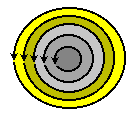
| |
 |
 ZetaTalk: Spin
ZetaTalk: SpinSpin is a phenomenon that occurs regularly in nature and is frequently observed on Earth, from the large swirls that hurricanes form to the small tornadoes in the middle of water going down the drain. The fact that such a spin moves in different directions when it is above or below the equator gives evidence that spin is affected by factors outside of itself. The phenomenon of spin is observable when the object in motion is not constrained. Air and water are fluid, but spinning tops or figure skaters on ice also demonstrate the phenomena. The theoretical speed of a spin is fastest toward the center of the spinning object, a factor easily noted by comparing hurricane wind speeds with those at the center of tornadoes. But why the difference?
Spin on the surface of the Earth reflects what is occurring in the core of the Earth. If the Earth were not rotating, its core moving to escape or pull toward other matter in the Solar System and beyond, then spin would be affected only by the various attractions or repulsion the spinning object itself has to its immediate neighborhood. All objects on the face of the Earth have these same influences from the core of the Earth, but this is not evident due to lack of fluidity or lack of motion. Spin in an object develops slowly, and is only evident to man when accumulated. Thus, water in a water fall has spin, but the water at the bottom of the fall cannot affect the water at the top, so the spin is not compounded. Water in a drain compounds the spin at the top by affecting the path of least resistance for the water at the top of the drain, and thus the little tornadoes in draining water.
Spin occurs faster when the spinning object is narrow as there are fewer factors to counter the spin. A large air mass such as is moving during a hurricane is spread out over a larger area of the core of the Earth, and thus the impetus to move with the core is countered by the fact that one of the outer edges, the one on the pole side, is lined up over core parts that are moving slower than the other outer edge, the one on the equator side. Thus small tops can spin faster for the given impetus than large tops, and figure skaters find they can spin faster by reducing their overall size by drawing their arms in and hugging themselves.